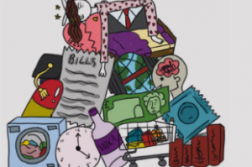Fast Fashion has become the bane of modern ethical sensibilities; it’s damaging to the environment, workers and our bodies, yet it shows few signs of slowing down any time soon. What was once an effort of high street brands to translate catwalk designs to the rail has been flipped on its head, with fast fashion brands producing lines faster than fashion houses.
LA-based brand Fashion Nova, described by their CEO as ‘Ultra-Fast Fashion’, churns out between 600-900 new products every week. We know before we buy them that nothing this cheap can be good quality, yet we buy it anyway, so why does Fast-Fashion have such a vice grip on our shopping habits, and can this ever really end?
Why should Fast-Fashion end?
The Fashion Industry produces the third largest amount of global pollution, including 5% of the world’s greenhouse gases (according to the Climate Council), and a third of ocean microplastics (which have recently been discovered in human blood for the first time). This pollution comes from every stage of a garment’s life cycle: there is a reliance on synthetic fibres such as Polyester and Nylon, which use up approximately 342 million barrels of oil every year.
So, let’s switch back to Cotton, you say?
Well, Cotton is just as bad, requiring several tonnes of freshwater, chemical pesticides and fertilisers, (a single pair of denim jeans costs 1,800 gallons of water.) Then there’s the actual process of making and transporting, and all this before it ends up being one of 10,000 other pieces of clothing which end up in landfill every five minutes.
Global Fashion Agenda has estimated that the number of clothes dumped in landfills by 2030 will rise from 92 million tonnes to 134 million tonnes per year. In addition to this, 93% of fashion brands are still not paying a living wage despite capitalising on fad trends, cheap products and their workers’ lives. Overall, it is clear that these Fast Fashion brands are damaging at every stage of production. The fashion industry is killing us, yet we continue to embrace our executioner with blind hope and credit cards at the ready.
Does individual sustainability help?
Making your wardrobe sustainable is a hot topic, countless articles are giving you the same advice about donating your clothes, buying second-hand and buying from sustainable brands. But unfortunately, these options aren’t that realistic. Charities have become so overwhelmed with donations thanks to fad trends that clothing donations have rocketed to 700,000 tonnes in the UK alone, a huge percentage of this still ends up in landfills (according to Oxfam, approximately 13 million items of clothing every week).
Buying second-hand is good in theory but often disappointing. It takes a lot of time and slogging through already outdated Shein tops is quite disheartening, also, the quality of some of the products is not okay. (I swear if I have to soak another top in baking soda and vinegar to get rid of the tobacco smell…) Second-hand market places such as Depop and Vinted have become somewhat of a centre for fake designer garms and the ‘Depop Girlie’ who will try and sell you their little brother’s Gap Tee from 2008 for £35.
Good alternatives are TRAID and iSecondthat, but a consistent downfall is limited choices and the simple fact that in some ways you’re still contributing to fast fashion, as these brands couldn’t exist if it weren’t for the fast turnover of the industry. Sustainable brands then? Well, to burst that bubble… Most of these brands have to charge more than the average person can afford in order to cover the true costs of production and employment, many fail due to the high costs and dominance of fast fashion brands, and those which do survive only manage to do so on the back of a personality, think WeAreTala and Grace Beverley. What will Tala’s longevity be once Beverley has ceased to be the current woman of the moment?
But regardless, each of these efforts has good intentions, and individual sustainability is not, on the whole, a bad thing to engage in, but is placing the blame on the consumer fair? No, of course not, just like taking a 10-minute cold shower will not save the planet, neither will one person boycotting Zara.
What will it take to see the end of the fast fashion industry?
A Fast Fashion free world would see better quality garments, a return to make and mend culture, a focus on small and local businesses rather than global outsourcing, fewer large fashion companies and fewer influencers promoting a fashion haul culture to their followers. Idyllic, isn’t it?
Unfortunately, as demonstrated by recent efforts to call for accountability in the fashion industry, fast fashion has become so ingrained in our global landscape that the only way this could improve, let alone end, is through drastic legislation. The Face recommends Governmental Reforms and Eco-tariffs, although considering how companies still avoid paying their workers fairly, you have to doubt the likelihood of this making any sort of effective change. Non-profit organisations such as Fashion Revolution and Re/Make have started to challenge the lack of Government legislation concerning the pollution of the industry; however, it is an unfortunate fact that the change needed is unlikely to happen until something disastrous occurs on a global scale.



